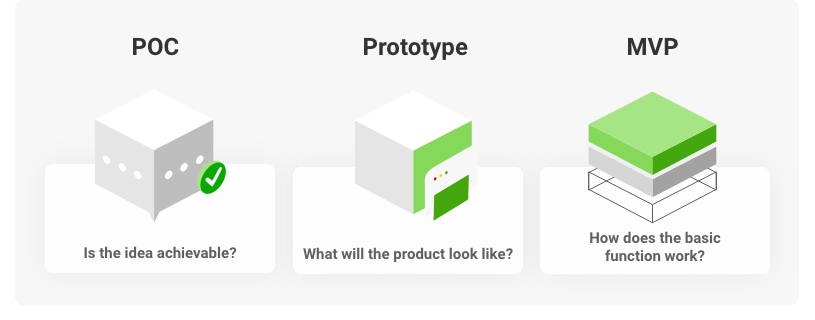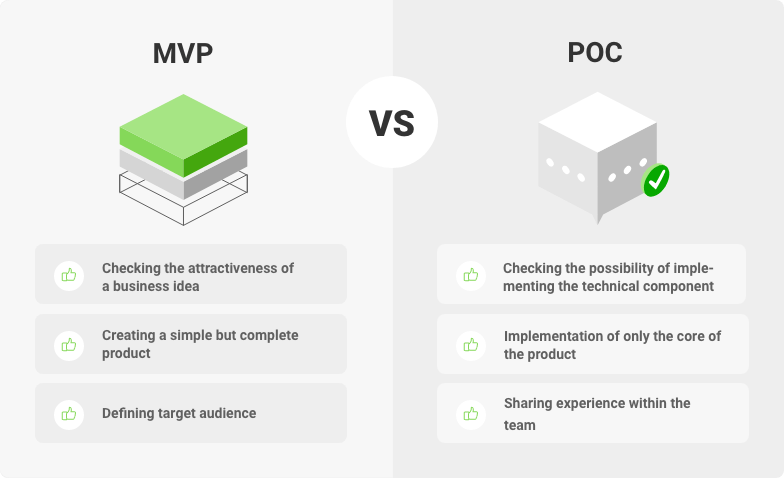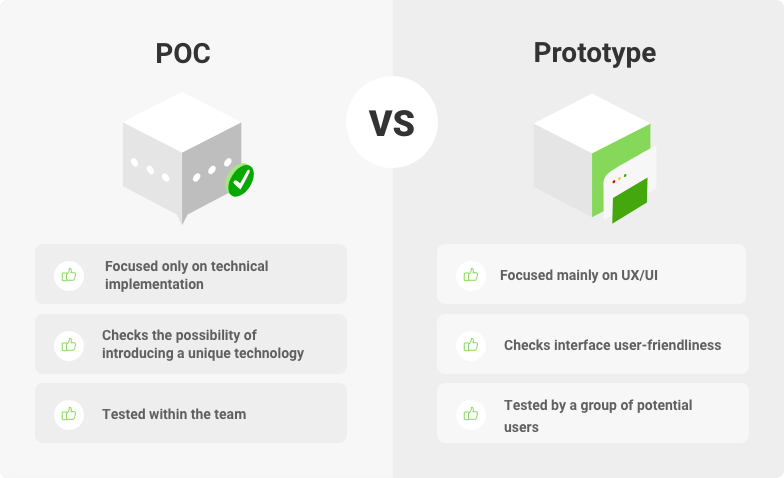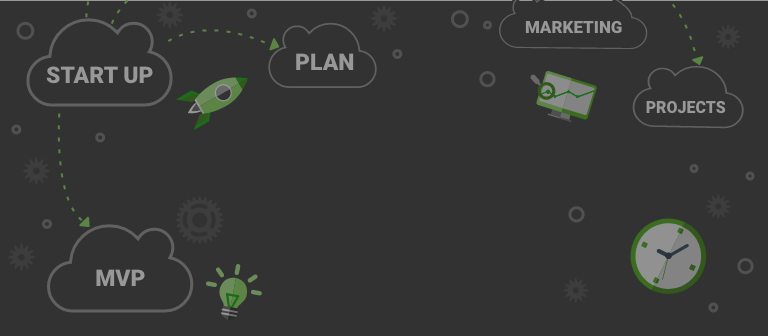Many companies enter the market ignoring necessary research and thus fail. It's natural to make mistakes, but some mistakes can be too expensive. Budget overruns, dissatisfaction with market needs, and the impossibility of implementing certain aspects of the system can be avoided by knowing the goals of MVP vs prototype vs POC and applying it in practice.
This article will take a closer look at the differences between these concepts in custom development and give a clear guideline for knowing which model to use.

What is a Minimum Viable Product (MVP)?
A minimum viable product (MVP) is a web, mobile, or desktop application with basic functionality designed to test the market response to a business idea. An MVP is a simple yet complete product. It is devoid of many advanced features and only focuses on the core of the idea.
The term became widespread after the publication of the Lean Startup book written by Eric Ries. Many well-known brands (Airbnb, Spotify, Groupon, Zappos, etc.) started as MVPs. Before creating a feature-rich product, they tested their main idea on a target audience. This made it possible to assess the relevance of the business idea and get to know customers better with minimal resource spendings.
Definition of MVP guide will help you get more useful information about the minimum viable product.
The distinctive feature of a minimum viable product is quality. Many people mistakenly think that an MVP is a raw version of an application. But believing this will only lead to failure. MVP implies a simple product, but at the same time, it must be of high quality to interest the target audience. This includes easy navigation, beautiful design, and an intuitive interface.
MVP implies a set of minimal functions that should interest the target audience. Despite its limitations, this is a complete product designed to assess the market reaction. Users' feedback will determine the fate of the product. - Andrey Onopriyenko, CTO, KeyUA
Benefits of building an MVP:
- Cost-effective to develop
- Allows you to get feedback from the target audience
- Checks the relevance of a business idea
Ready to implement your brilliant idea? Hire full stack developers to build a powerful product.
Contact UsWhat is Proof of Concept (POC)?
A proof-of-concept (POC) is an approach that a development team uses to test the feasibility of a particular technical feature. However, this concept is not only widely used in IT. It is also prevalent in other industries, such as mechanical engineering or film production.
A POC intends to confirm that the implementation will work as planned. For example, the team is going to use relatively complex technology. To make sure they can handle this, developers build critical parts of the system using chosen technology. It is also an excellent opportunity to share experiences within the team. In the case of a POC, only basic parts are created, not the entire system. It helps assess the practicality of the idea and calculate the risks before starting the main development stage.
It is worth noting that the POC is not a full-fledged product. These are only some parts of the functionality of the intended system. It will never be put on the market as it is. A proof of concept is developed for internal use by a company to draw specific technical conclusions.
It also serves to test ideas that are not yet well developed in the market. For example, if you want to build a social network, there is no point in a proof-of-concept. Since the steps and the technological stack have been known for a long time. But if you have an unusual idea that has not yet become widespread, the POC concept should definitely be implemented.
Benefits of building POC:
- Helps to assess the risks of technical implementation
- Allows reducing the number of possible failures at later stages of development
- Demonstrates financial viability for investors
What is a Prototype?
A prototype is an attempt to visualize a business idea. It reflects the main functions of the product and can be prepared in any form. The prototype can be either drawn on paper or made as a functional application. Moreover, the prototype is still not a full-fledged product but only a simplified version.
Prototypes are relatively fast and inexpensive to implement. They allow you to evaluate design and functionality, get feedback from a control group, and use resources efficiently. But it is still far from the end product in terms of design, usability, and functionality.
The prototype is tested on a small group of potential users and should not be introduced to the market, as it is still a crude model. It can also be tested internally. The main task is to understand how convenient and interesting it will be for the target audience to work with the product.
When developing a prototype, you can make as many changes and improvements to the concept as you want before the product is completed. This is pretty convenient as it minimizes errors and increases the success of an app launch. In addition, you receive feedback from real people, thus getting the opportunity to improve your business idea quickly.
Benefits of building prototypes:
- Requires a minimum of resources to implement
- Reduce budget costs when a product goes to market
- Provide additional grounds for investors to make a favorable decision
MVP vs POC

Both of these concepts are used to draw specific conclusions before creating a multifunctional product. A proof of concept aims to verify certain information for internal use by the development team, while the purpose of an MVP is to test the market.
The main difference between MVP and POC is that the second represents only a particular part of the system, or rather its basic features. It has no design and, in general, is not yet ready to be used by clients. An MVP is a ready-made product. Although it includes only a basic business idea, it features convenient navigation and a high-quality design.
Creating a minimum viable product is a great idea for any startup because it allows you to assess the relevance of a business idea before you spend the entire budget on its implementation. It is also convincing evidence for investors.
With a proof of concept, that is not always the case. It is used for creating a product based on innovative technologies. For example, if you want to create something analogous to what is already on the market, a POC is a waste of resources since all implementation steps have already been tested.
But if your target is something unique (like a rocket flying to Mars) that you plan to release for general use, a proof of concept is essential. Its goal is to make sure that you have all the resources and knowledge for the technical implementation.
MVP vs Prototype

Both MVP and prototype concepts are good ideas when initiating a startup. But at the same time, they do not replace each other; rather, they complement. In the case of an MVP, this is a fully market-ready product. A prototype is a draft that still needs some work before it is ready for use by clients.
Despite their fundamental differences, both products are designed to detect certain ‘errors.’ An MVP is a simple version of a product. Thus, it tests the market's attitude towards a given business idea. It helps to understand whether the target audience needs such a product, and if the answer is negative, it makes it possible to find out what should be changed for the application to become in demand.
Potential users test the prototype. This is a small group of people who fit the parameters of your target audience. The group must be formed well in advance, which is not the same as going to the market. Prototype testing takes place in a closed environment. The goal is to understand whether potential users will find it convenient to interact with your app. Another significant difference is that you can create various prototypes for the same product to test their concepts with potential users, but there should be only one MVP.
Basically, a minimum viable product is created taking into account a prototype's peculiarities. The MVP must be of high quality to attract the attention of the target audience. This is difficult to achieve without first creating a prototype. - Andrey Onopriyenko, Chief Technology Officer at KeyUA
POC vs Prototype

Some software developers are debating that a prototype and POC are practically the same things. Even though both of these concepts aim to create some parts of the system, this statement is still erroneous. Let’s consider the main difference between POC and prototype.
A proof of concept often implements one of the most basic functions of a future product. The goal is to make sure the team has the technical resources to create it. The prototype covers several aspects of the system. In other words, it is a raw application. The visual part of the system is usually not created for proof-of-concept, but only the backend. The prototype is always based on front-end testing. Its creation is to appreciate the design, usability, and functionality.
Thus, product development has three main stages: proof of concept, then prototyping begins, and at the end, an MVP is built.
MVP vs PoC vs Prototype: Comparison Table
We have figured out the concepts of POC vs MVP vs prototype in more detail. Now it's time to compile a summary table of their characteristics.
| POC | Prototype | MVP | |
| The purpose | Testing the technical feasibility of an idea or one (basic) function | Checking the implementation and usability of several functions | Market validation of a business idea |
| Functionality | It consists of the core function | It consists of several functions (some may not have adopted by MVP) | Essential functions to stay viable |
| Who tests? | Inner development team | Inner development team, small closed group of the target audience, investors | Market |
| Further usage | The implementation of the function can be used in further development | The implementation of the design can be used in further development. | The first version of the product |
| Development time | Days of weeks | Weeks of Months | At least a couple of months |
| Value | Backlog for the future | Potential for product creation | Ready-made product |
| When to develop? | When it is not known whether it is possible to technically implement an idea or a separate function | When the business case is not proven, the risks are unknown | When there is funding, and the risks are minimal |
| Required resources | Requires technical expertise to implement an idea | Almost no technical resources are required, there may be no development | Need technical expertise and resources to create a product |
How to Choose the Best Approach for Your Startup?
When it comes to the POC vs prototype vs MVP battle, one is neither better nor worse. They are not competitors, and each concept is appropriate under certain conditions. But before you start implementing any of them, you have to answer several essential questions:
- What is my business idea? How can I check this?
- What resources do I have?
- What are my target audience and competitors?
To summarize all of the above, here are a few key aspects to help you understand when to develop a POC or prototype, MVP or POC, etc.
You need a POC if:
- You want to make an informed decision about the development process;
- When you want to create a product that has no analogs on the market;
- Investors are waiting for a technical justification of your idea;
- It is necessary to share technical knowledge within the team.
You need a prototype if:
- You want to render the look of the application;
- Investors want to know how the product will look;
- You want to get feedback from real users before you start large-scale development;
- You have a tight deadline to showcase your idea.
You need an MVP if:
- You need to assess the market perception of your business idea;
- You need to monetize your idea;
- You need a finished product;
- You want to achieve target audience retention.
Also, the diagram below will help you choose the right option for you.

Conclusion
Many startups fail. This is mainly due to insufficient market research, especially regarding the needs of the target audience. Approaches to the development of a product such as a POC, prototype, and MVP will allow any startup company to prepare for app building and more successfully enter the market.
However, the choice of POC, MVP, or prototype should be based on the characteristics of your idea. You can use one of these concepts or all three at once, depending on market conditions and your goals.
If you are not sure where to start implementing your business idea, KeyUA specialists will effectively help you find the right solution.
Contact Us







 Unit 1505 124 City Road, London, United Kingdom, EC1V 2NX
Unit 1505 124 City Road, London, United Kingdom, EC1V 2NX

Comments
Leave a comment